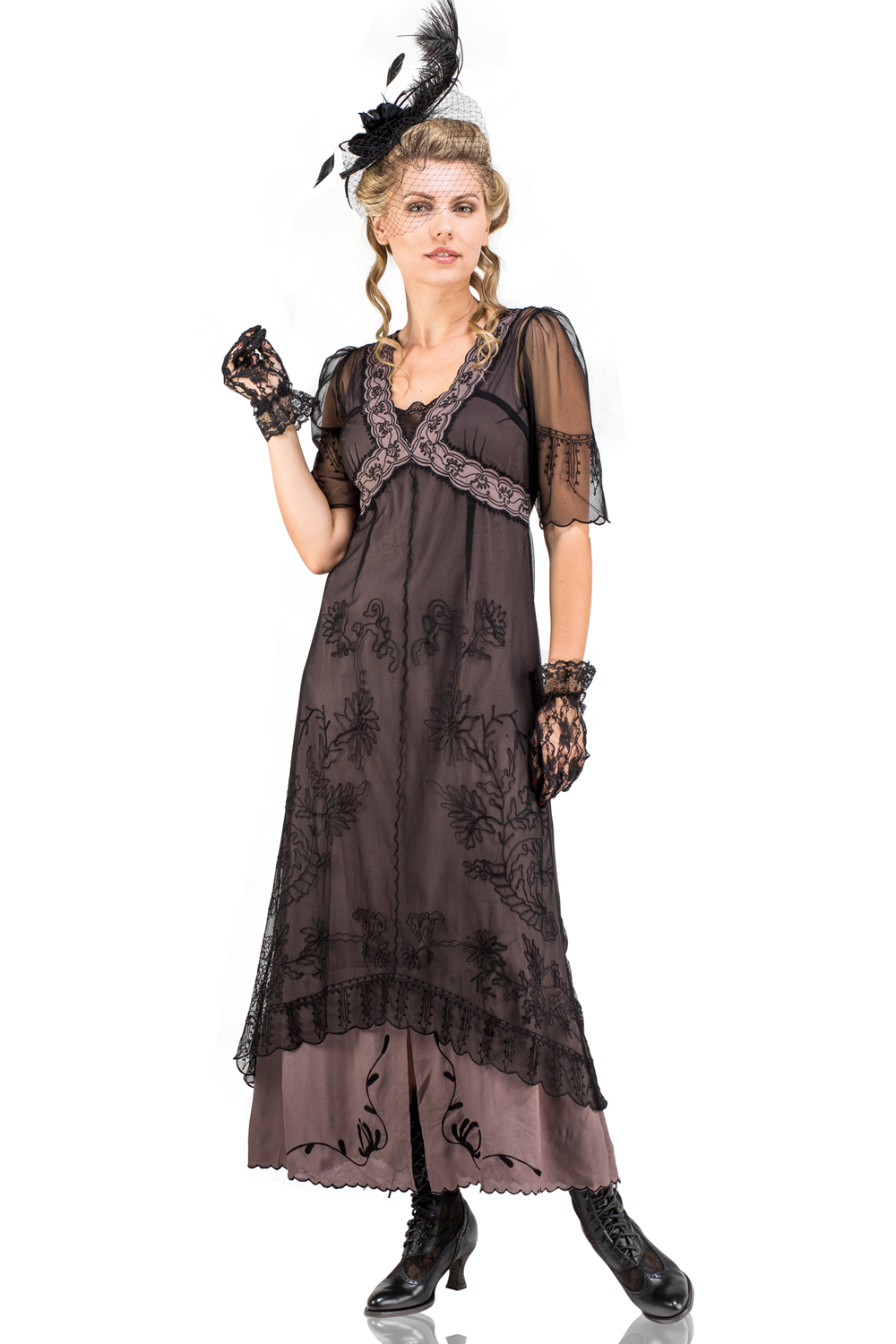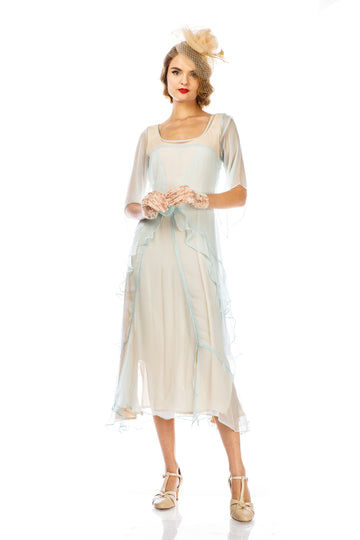
1962 Cocktail Dresses
December means party time. Between office sponsored Holiday parties, dinner parties with friends and fancy New Years Eve events it is a time of year to wear my best vintage cocktail dresses.
The history of the vintage cocktail dress is an interesting one. Informality after World War I (and the end of Prohibition) started a new semi formal fad for pre-dinner attire between 3 and 8pm. Unlike full dinner gowns which were floor length with rich jewelry and full accessories, the cocktail dress was shorter, lighter, and less ornamented. Depending on a women’s class, her cocktail party dress could be a less formal version of a very formal gown or an upscale version of a day dress. These in-between styles were pretty and festive, yet easy to move in for dancing, drinking, and semi-formal dining.
Take a look and see how the vintage cocktail dress evolved from the 1920s to the 1960s as well as some suggestions of creating a vintage inspired look for each decade using clothes I found at Modcloth (thank you Modcloth for sponsoring this article).
**This post contains affiliate links and I will be compensated if you make a purchase after clicking on my links.
1920s Vintage Cocktail Dresses
It is easy to image women in elegant beaded flapper dresses drinking and dancing in speakeasies during the roaring twenties. While the cocktail dress eventually became the iconic flapper dress, its early origins were much more dainty. Ankle length dresses made of chiffon with ruffled hems and draped layers and the sleek slip dress were the preferred styles between 1918 and 1924.

1923 chiffon slip / cocktail dress with ruffled hem

Mid 1920s party dresses

1927 uneven hem cocktail dress

Actress Blanche Sweet, 1920s beaded evening party dress
By the mid ’20s, the elaborately beaded dresses we know and love today were in full fashion. They were great for drinking and dancing her cares away. A pair of T- strap dancing shoes were a must, as well as a headband or other hair accessories. A long or short necklace, long gloves, and maybe a bunch of loose bracelets were her only needed accessories.
To get a 1920s cocktail dress look today is much easier than it has been in the past thanks to a revival of beaded and sequin shift dress (which are more ’60s than ’20s, but we’ll ignore that for now). Pair a beaded dress with a pair of strappy shoes (T straps, mary jane, or even plain pumps) in a color to coordinate with the dress or other accessories. A sparkling headband is a nice touch for an authentic ’20s look. Modcloth paired their outfit below with a short faux fur shrug. Its adorable, and while it isn’t authentic to the ’20s style, it offers an overall vintage feel. A scarf, wrap or fringe kimono coat would be more accurate option.

1920s inspired cocktail dress, shoes and shrug at Modcloth
1930s Vintage Cocktail Dresses

1930s short sleeve, ankle length cocktail dresses
Cocktail party dresses in the twenties were usually sleeveless and usually short (shin to below knee length). In the thirties, they were the opposite. A cocktail dress for most of the 1930s was ankle length, maybe a tad shorter, but not the mid shin length of most day dresses or the ground sweeping length of formal gowns. They also were worn with sleeves. Adding sleeves made them much more versatile while moving from an afternoon tea to cocktails without needing to change clothing. Some leading ladies favored the wide leg pant suit instead of a dress for cocktail attire. This was one of the first instances where sportswear merged with formal wear.
In summer, cocktail dresses replaced expensive silk and lace with floral prints on chiffon. If you watched Indian Summers, you may recognize most of the dresses worn at the “club” were long floral dresses with short sleeves. Sleeveless dresses were reserved for formal gowns and summer garden parties only. Popular colors were black, peach, pink, green and blue. In winter, darker jewel tones were worn.

1930 afternoon or coattail dresses becoming longer and more modest.

Long dresses in bold prints for cocktail attire

1930s party dresses

Late 1930s long and *new* short dress style appropriate for cocktail time.
1930s formal wear with floor length draping, open backs, no sleeves and lots of sequins are back in style now. They however are not historically accurate for a ’30s cocktail party dress which I have found nearly impossible to find. You have my permission to go for broke and wear your glamorous evening gowns to a cocktail party.
For this look below, I chose a peach lace sleeveless gown (very popular ’30s color and style) and paired it with T strap peachy-gold heels. Just like in the 1920s, 1930s women loved to wear gold and silver strappy heels for evening wear. They also wore bracelets, several at once, as a bit of bling. A matching pair of small earrings helped coordinate it all together. The lightness of the dress brings the formality of 1930s evening wear down to a cocktail level.

1930s style lace cocktail dress with T strap shoes, bracelet, and earrings at Modcloth
1940s Vintage Cocktail Dresses
Dior was the first to label a dress “cocktail.” Prior to that, cocktail time dresses were still called social dresses or dinner dresses. The late 30s saw hemlines rise to almost the knee with wider puffed sleeves, a trim waist, and a flared skirt. Once WWII was in full effect, the lines between afternoon, cocktail, and evening blurred even more. Few women had reason to wear full formal wear. Instead, cocktail party dresses, based on day and afternoon dresses, were upgraded with material and style. A nice A-line dress in rayon, satin, or velvet worked for most women. Many women wore two peice suit dresses as well. The overall look was clean and sophisticated.

1946 formal gown appropriate for cocktail hour.

Two long early 1940s cocktail dresses with pretty embellishments.

1942 short cocktail dress with small hat and long gloves.
If the cocktail dress had sleeves, it most likely had the ever-present sharp ’40s shoulder pads. These dresses often had shirring in the waist, one panel on either side, or in the bust. They often had a cross-wrapped bodice with draping to one side that took on the look of Grecian goddesses. These extra manipulations of the fabric created a semi formal look without layered on extra fabric. Subtle, but present nonetheless.

1940s cocktail look using a vintage velvet dress, hat, heels, jewelry and fur stole.
Accessories were a big deal in the 1940s since they could elevate an afternoon dress into cocktail attire. Gloves were still worn but were losing favor. A chunky necklace, earrings, brooch, and hair ornament added all the bling a dress needed.
The late 1940s started to see a slimming silhouette. Instead of an A-line skirt, dresses now had a slimmer pencil shape skirt. Pinups took these dresses in to create more curves with a tighter fit. These wiggle dresses are what most women think of when they want a 1940s cocktail dress.
For the late 1940s cocktail look below, I started with a black (a never-fail cocktail color) pencil dress with sheer top. A pair of black and white high heels match well with such a sexy dress. A small hat isn’t something most women would think to wear to a cocktail party but in the 1940s they did. I love this small veiled hat with bow from Modcloth. This is a timeless look for any occasion, day or night.

1940s cocktail dress with heels and small hat at Modcloth. Shop more 1940s cocktail dresses, shoes and hats.
1950s Vintage Cocktail Dresses
The above 40s cocktail dress look is one of the two silhouettes popular in the 1950s. It was fitted, a bit longer, and made with richer materials such as velvet, lace, silk, and taffeta. The opposite full skirted look was still fitted on top, often without sleeves, and fluffed out over several layers of petticoats. Both looks were worn equally as cocktail parties. Popular colors were black, white, emerald blue or green, and red. Big patterns were welcome, too, such as plaid, dots, and florals.
Accessories had to perfectly match the dress. Shoes, long or short gloves, clutch bags, wraps, and jackets were all made of the same color and often the same material as well. Sometimes, one contrasting accessory was worn.
The 1950s were the heyday of the cocktail dress. Women were hosting cocktail parties in their homes, attending their husband’s office parties, and in general were dressing nicer than the past few decades. Every woman owned a little black dress in her collection and wore it frequently.

Sheath and full silhouettes were worn equally with cocktail attire

Fitted Cocktail dresses

Dior, 1953, cocktail dresses in black and white

Most but not all cocktail dresses were solid colors. This plaid dress goes from day to night with upgraded accessories.

Late ’50s Flocked red dress and taffeta black cocktail dresses.

1950s strapless fitted cocktail dresses
A 1950 inspired cocktail look is very easy to do this year. It seems like most party dresses fall either into the 1920s beaded slip dress or 1950s fit and flare dress styles. Without all the extra accessories worn in the 1950s, a ’50s style cocktail dress looks simple and modern enough for any cocktail party. If you want to take it to a more vintage ’50s level, add matching gloves, tall or short kitten heel pumps, and rhinestone or crystal earrings and necklaces. Shop 1950s cocktail dresses here (with more vintage pictures too).
Here is another option I put together with a red and black theme.

1950s style red and black cocktail dress , jewelry and shoes at Modcloth
1960s Vintage Cocktail Dresses
Both ’50s silhouettes continued in the early 1960s. The full skirts became shorter to knee length and with less volume while the fitted dresses also shortened up and became a little less fitted and a bit more boxy. Matching half jackets became a big deal in the 1960s, partially because most dresses were sleeveless.
Black was still the most common color for party wear however gold and silver were big trends too. For those that wanted color, bright or pastel pink and sage green were popular options. Fabrics were still rich with velvet, lace, tulle, and brocades leading the way.
While flats dominated the day look, kitten heels or stiletto heels in matching colors were required for evenings. Other accessories didn’t need to match and were often avoided. Less was more in the 1960s, except for the ’20s does ’60s revival where beaded and sequined slip dresses came back in fashion. Now you know why so many ’20s inspired dresses have a shorter ’60s silhouette.

1961 Gold cocktail dresses were the new black.

1960 the two fifties silhouettes remained popular for most of the 1960s.

Green and golden yellow for a pop of mod color.

1964 Black cocktail dresses were everywhere. With or without sleeves and most with an above the knee length.

1964 Simple cocktail dresses for any day to evening party.
For my last cocktail look, I put together a beautiful gold fit and flare lace dress with matching sparkling gold heels, white gloves, and a chunky crystal necklace. I really want to wear this to my next party!

1960s inspired cocktail dress , jewelry, gloves and shoes ensemble at Modcloth
What cocktail decade is your favorite? Can’t decide? Then browse all vintage style cocktail dresses online.







































